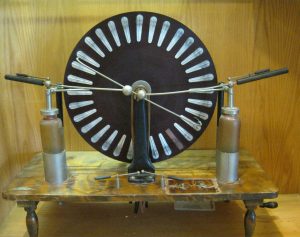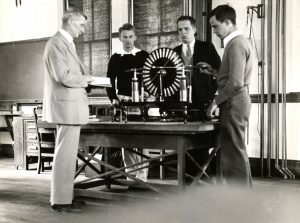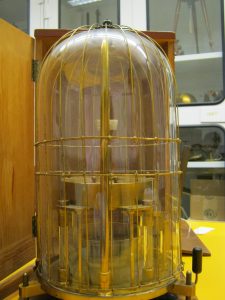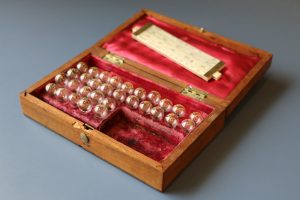Written by Mike Lally ‘18
If one were to walk around Bicentennial Hall, one could see strange contraptions, ranging from one foot high to three feet all, behind glass that appear to be large discs with mallets attached.

Wimshurst Machine
A device such as this is known as a Wimshurst machine. Invented in the 1880s by James Wimshurst, they belong to class of machines called electrostatic generators. Unlike other apparatus that create an electrostatic spark, a Wimshurst machine does so using induction rather than friction.
The two insulated discs rotate around, often by a mechanical crank, passing by neutralizer bars and brushes. Charges are induced onto the discs and collected onto the combs near the surface of the discs. The charges increase exponentially until the dielectric breakdown voltage of air is reached. When this occurs, a spark is created. The jars are Leyden jars, an early type of capacitor, and act to increase the accumulated charge.
This machine, although able to show the effects of electrostatic charges, can be put to other uses.

Professor Ernest C. Bryrant demonstrating how to operate this Wimshurst machine to students in a physics lab (c.1934).
Wimshurst machines at Middlebury College can be found on the 5th floor of BiHall and in Armstrong Library.

 lined box are 31 hand blown glass beads with number painted on in gold paint, and a bone slide rule. Engraved on a small ivory plaque on the lid of the box are the words “Lovi Edinr Patentee.” After Wendy informed me that Edinr stands for Edinburgh, I quickly googled to find that they are aerometrical, or specific gravity, beads. Beads such as these, also known as “philosophical beads”, were invented by Alexander Wilson of Glasgow in the 1750s, and were used to determine the specific gravity of a fluid. The user would drop the beads into a liquid until finding the one with neutral buoyancy, which would indicate the specific gravity. By using the slide rule, one could then, for example, find the alcohol content in wine.
lined box are 31 hand blown glass beads with number painted on in gold paint, and a bone slide rule. Engraved on a small ivory plaque on the lid of the box are the words “Lovi Edinr Patentee.” After Wendy informed me that Edinr stands for Edinburgh, I quickly googled to find that they are aerometrical, or specific gravity, beads. Beads such as these, also known as “philosophical beads”, were invented by Alexander Wilson of Glasgow in the 1750s, and were used to determine the specific gravity of a fluid. The user would drop the beads into a liquid until finding the one with neutral buoyancy, which would indicate the specific gravity. By using the slide rule, one could then, for example, find the alcohol content in wine.
You must be logged in to post a comment.